Red Mud-Amended Soil as Highly Adsorptive Hybrid-Fill Materials for Controlling Heavy Metal Sewage Seepage in Industrial Zone
Abstract
1. Introduction
2. Materials and Methods
2.1. Materials
2.2. Methods
2.2.1. Soil and Red Mud Mixing Method
2.2.2. Engineering Characteristics Test
2.2.3. Adsorption and Desorption Batch Test
2.2.4. Column Test
3. Results and Discussion
3.1. Engineering Characteristics Test
3.2. Adsorption Batch Test
3.3. Adsorption Isotherm
3.4. Desorption Test
3.5. Column Test
3.5.1. Influence of Initial Concentration
3.5.2. Influence of Hybrid-Fill Material Layer Thickness
3.5.3. Relationship between Soil Column Useful Time and Test Parameters
4. Conclusions
Author Contributions
Funding
Institutional Review Board Statement
Informed Consent Statement
Data Availability Statement
Conflicts of Interest
References
- Li, C.; Zhou, K.; Qin, W.; Tian, C.; Qi, M.; Yan, X.; Han, W. A Review on Heavy Metals Contamination in Soil: Effects, Sources, and Remediation Techniques. Soil Sediment Contam. Int. J. 2019, 28, 380–394. [Google Scholar] [CrossRef]
- Khan, S.; Cao, Q.; Zheng, Y.M.; Huang, Y.Z.; Zhu, Y.G. Health Risks of Heavy Metals in Contaminated Soils and Food Crops Irrigated with Wastewater in Beijing, China. Environ. Pollut. 2008, 152, 686–692. [Google Scholar] [CrossRef] [PubMed]
- Ali, H.; Khan, E. Trophic Transfer, Bioaccumulation, and Biomagnification of Non-Essential Hazardous Heavy Metals and Metalloids in Food Chains/Webs—Concepts and Implications for Wildlife and Human Health. Hum. Ecol. Risk Assess. Int. J. 2019, 25, 1353–1376. [Google Scholar] [CrossRef]
- Munir, N.; Jahangeer, M.; Bouyahya, A.; El Omari, N.; Ghchime, R.; Balahbib, A.; Aboulaghras, S.; Mahmood, Z.; Akram, M.; Ali Shah, S.M.; et al. Heavy Metal Contamination of Natural Foods Is a Serious Health Issue: A Review. Sustainability 2021, 14, 161. [Google Scholar] [CrossRef]
- Sall, M.L.; Diaw, A.K.D.; Gningue-Sall, D.; Efremova Aaron, S.; Aaron, J.-J. Toxic heavy metals: Impact on the environment and human health, and treatment with conducting organic polymers, a review. Environ. Sci. Pollut. Res. 2020, 27, 29927–29942. [Google Scholar] [CrossRef]
- Huang, W.; Shi, X.; Wu, K. Human Body Burden of Heavy Metals and Health Consequences of Pb Exposure in Guiyu, an E-Waste Recycling Town in China. Int. J. Environ. Res. Public Health 2021, 18, 12428. [Google Scholar] [CrossRef]
- Genchi, G.; Sinicropi, M.S.; Lauria, G.; Carocci, A.; Catalano, A. The Effects of Cadmium Toxicity. Int. J. Environ. Res. Public Health 2020, 17, 3782. [Google Scholar] [CrossRef]
- Qing, X.; Yutong, Z.; Shenggao, L. Assessment of heavy metal pollution and human health risk in urban soils of steel industrial city (Anshan), Liaoning, Northeast China. Ecotoxicol. Environ. Saf. 2015, 120, 377–385. [Google Scholar] [CrossRef]
- Wu, W.; Wu, P.; Yang, F.; Sun, D.-L.; Zhang, D.-X.; Zhou, Y.-K. Assessment of heavy metal pollution and human health risks in urban soils around an electronics manufacturing facility. Sci. Total Environ. 2018, 630, 53–61. [Google Scholar] [CrossRef]
- Wei, B.; Yang, L. A review of heavy metal contaminations in urban soils, urban road dusts and agricultural soils from China. Microchem. J. 2010, 94, 99–107. [Google Scholar] [CrossRef]
- Rajendran, S.; Priya, T.; Khoo, K.S.; Hoang, T.K.; Ng, H.-S.; Munawaroh, H.S.H.; Karaman, C.; Orooji, Y.; Show, P.L. A critical review on various remediation approaches for heavy metal contaminants removal from contaminated soils. Chemosphere 2022, 287, 132369. [Google Scholar] [CrossRef]
- Song, P.; Xu, D.; Yue, J.; Ma, Y.; Dong, S.; Feng, J. Recent Advances in Soil Remediation Technology for Heavy Metal Con-taminated Sites: A Critical Review. Sci. Total Environ. 2022, 838, 156417. [Google Scholar] [CrossRef]
- Gusiatin, Z.M.; Kulikowska, D.; Klik, B. New-Generation Washing Agents in Remediation of Metal-Polluted Soils and Methods for Washing Effluent Treatment: A Review. Int. J. Environ. Res. Public Health 2020, 17, 6220. [Google Scholar] [CrossRef]
- Dhaliwal, S.S.; Singh, J.; Taneja, P.K.; Mandal, A. Remediation Techniques for Removal of Heavy Metals from the Soil Con-taminated through Different Sources: A Review. Env. Sci. Pollut. Res. 2020, 27, 1319–1333. [Google Scholar] [CrossRef]
- Jiang, Q.; He, Y.; Wu, Y.; Dian, B.; Zhang, J.; Li, T.; Jiang, M. Solidification/stabilization of soil heavy metals by alkaline industrial wastes: A critical review. Environ. Pollut. 2022, 312, 120094. [Google Scholar] [CrossRef]
- Lu, L.; Xie, Y.; Yang, Z.; Chen, B. Sustainable decontamination of heavy metal in wastewater and soil with novel rectangular wave asymmetrical alternative current electrochemistry. J. Hazard. Mater. 2022, 442, 130021. [Google Scholar] [CrossRef]
- Otunola, B.O.; Ololade, O.O. A review on the application of clay minerals as heavy metal adsorbents for remediation purposes. Environ. Technol. Innov. 2020, 18, 100692. [Google Scholar] [CrossRef]
- Wang, S.; Jin, H.; Deng, Y.; Xiao, Y. Comprehensive utilization status of red mud in China: A critical review. J. Clean. Prod. 2021, 289, 125136. [Google Scholar] [CrossRef]
- Xu, Y.; Liang, X.; Xu, Y.; Qin, X.; Huang, Q.; Wang, L.; Sun, Y. Remediation of Heavy Metal-Polluted Agricultural Soils Using Clay Minerals: A Review. Pedosphere 2017, 27, 193–204. [Google Scholar] [CrossRef]
- Wang, M.; Liu, X. Applications of red mud as an environmental remediation material: A review. J. Hazard. Mater. 2021, 408, 124420. [Google Scholar] [CrossRef]
- Ma, Y.; Lin, C.; Jiang, Y.; Lu, W.; Si, C.; Liu, Y. Competitive Removal of Water-Borne Copper, Zinc and Cadmium by a Ca-CO3-Dominated Red Mud. J. Hazard. Mater. 2009, 172, 1288–1296. [Google Scholar] [CrossRef] [PubMed]
- Kocabaş, Z.; Yürüm, Y. Kinetic Modeling of Arsenic Removal from Water by Ferric Ion Loaded Red Mud. Sep. Sci. Technol. 2011, 46, 2380–2390. [Google Scholar] [CrossRef]
- Cho, D.-W.; Yoon, K.; Ahn, Y.; Sun, Y.; Tsang, D.C.; Hou, D.; Ok, Y.S.; Song, H. Fabrication and environmental applications of multifunctional mixed metal-biochar composites (MMBC) from red mud and lignin wastes. J. Hazard. Mater. 2019, 374, 412–419. [Google Scholar] [CrossRef] [PubMed]
- Hayrunnisa, N.; Ekrem, K. Removal of Cobalt (II) Ions from Aqueous Solution by Using Alternative Adsorbent Industrial Red Mud Waste Material. Int. J. Phys. Sci. 2012, 7, 1386–1394. [Google Scholar] [CrossRef]
- Hua, Y.; Heal, K.V.; Friesl-Hanl, W. The use of red mud as an immobiliser for metal/metalloid-contaminated soil: A review. J. Hazard. Mater. 2017, 325, 17–30. [Google Scholar] [CrossRef]
- Oprčkal, P.; Mladenovič, A.; Zupančič, N.; Ščančar, J.; Milačič, R.; Zalar Serjun, V. Remediation of Contaminated Soil by Red Mud and Paper Ash. J. Clean. Prod. 2020, 256, 120440. [Google Scholar] [CrossRef]
- Taneez, M.; Hurel, C. A review on the potential uses of red mud as amendment for pollution control in environmental media. Environ. Sci. Pollut. Res. 2019, 26, 22106–22125. [Google Scholar] [CrossRef]
- Luo, L.; Ma, C.; Ma, Y.; Zhang, S.; Lv, J.; Cui, M. New insights into the sorption mechanism of cadmium on red mud. Environ. Pollut. 2011, 159, 1108–1113. [Google Scholar] [CrossRef]
- Kalkan, E. Utilization of red mud as a stabilization material for the preparation of clay liners. Eng. Geol. 2006, 87, 220–229. [Google Scholar] [CrossRef]
- Mukiza, E.; Zhang, L.; Liu, X.; Zhang, N. Utilization of red mud in road base and subgrade materials: A review. Resour. Conserv. Recycl. 2019, 141, 187–199. [Google Scholar] [CrossRef]
- GB5085.3-2007; Identification Standards for Hazardous Wastes-Identification for Extraction Procedure Toxicity. China Environmental Science Press: Beijing, China, 2007.
- D3080//D3080M-11; Standard Test Method for Direct Shear Test of Soils under Consolidated Drained Conditions. ASTM: West Conshohocken, PA, USA, 2011.
- D5084; Standard Test Methods for Measurement of Hydraulic Conductivity of Saturated Porous Materials Using a Flexible Wall Per-meameter. ASTM: West Conshohocken, PA, USA, 2010.
- Chuang, C.L.; Fan, M.; Xu, M.; Brown, R.C.; Sung, S.; Saha, B.; Huang, C.P. Adsorption of arsenic(V) by activated carbon prepared from oat hulls. Chemosphere 2005, 61, 478–483. [Google Scholar] [CrossRef]
- Sircar, S.; Hufton, J. Why Does the Linear Driving Force Model for Adsorption Kinetics Work? Adsorpt. J. Ternational Adsorpt. Soc. 2000, 6, 137–147. [Google Scholar] [CrossRef]
- Di, J.; Ruan, Z.; Zhang, S.; Dong, Y.; Fu, S.; Li, H.; Jiang, G. Adsorption behaviors and mechanisms of Cu2+, Zn2+ and Pb2+ by magnetically modified lignite. Sci. Rep. 2022, 12, 1394. [Google Scholar] [CrossRef]
- Zhang, T.; Tu, Z.; Lu, G.; Duan, X.; Yi, X.; Guo, C.; Dang, Z. Removal of heavy metals from acid mine drainage using chicken eggshells in column mode. J. Environ. Manag. 2017, 188, 1–8. [Google Scholar] [CrossRef]
- Krishnan, K.A.; Sheela, A.; Anirudhan, T. Kinetic and equilibrium modeling of liquid-phase adsorption of lead and lead chelates on activated carbons. J. Chem. Technol. Biotechnol. 2003, 78, 642–653. [Google Scholar] [CrossRef]
- Eren, Z.; Acar, F.N. Adsorption of Reactive Black 5 from an aqueous solution: Equilibrium and kinetic studies. Desalination 2006, 194, 1–10. [Google Scholar] [CrossRef]
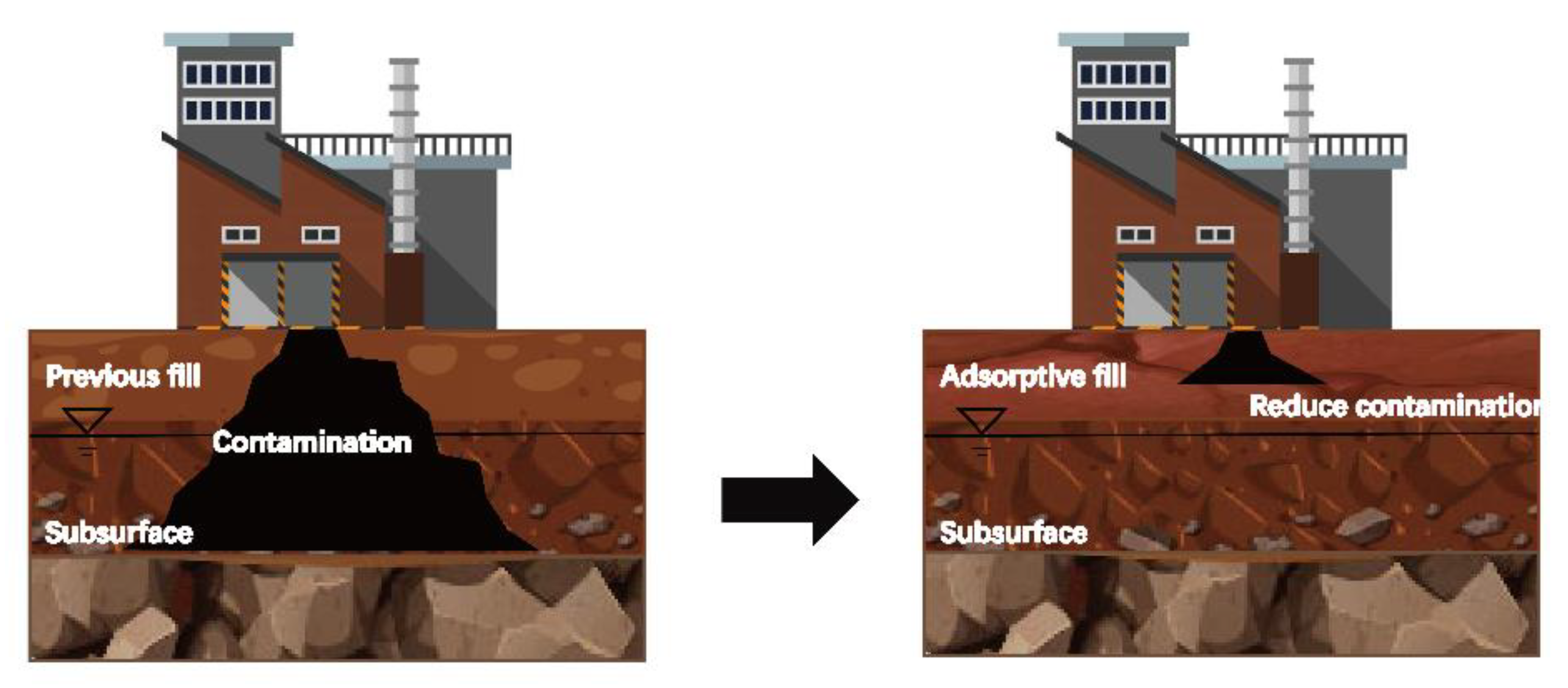
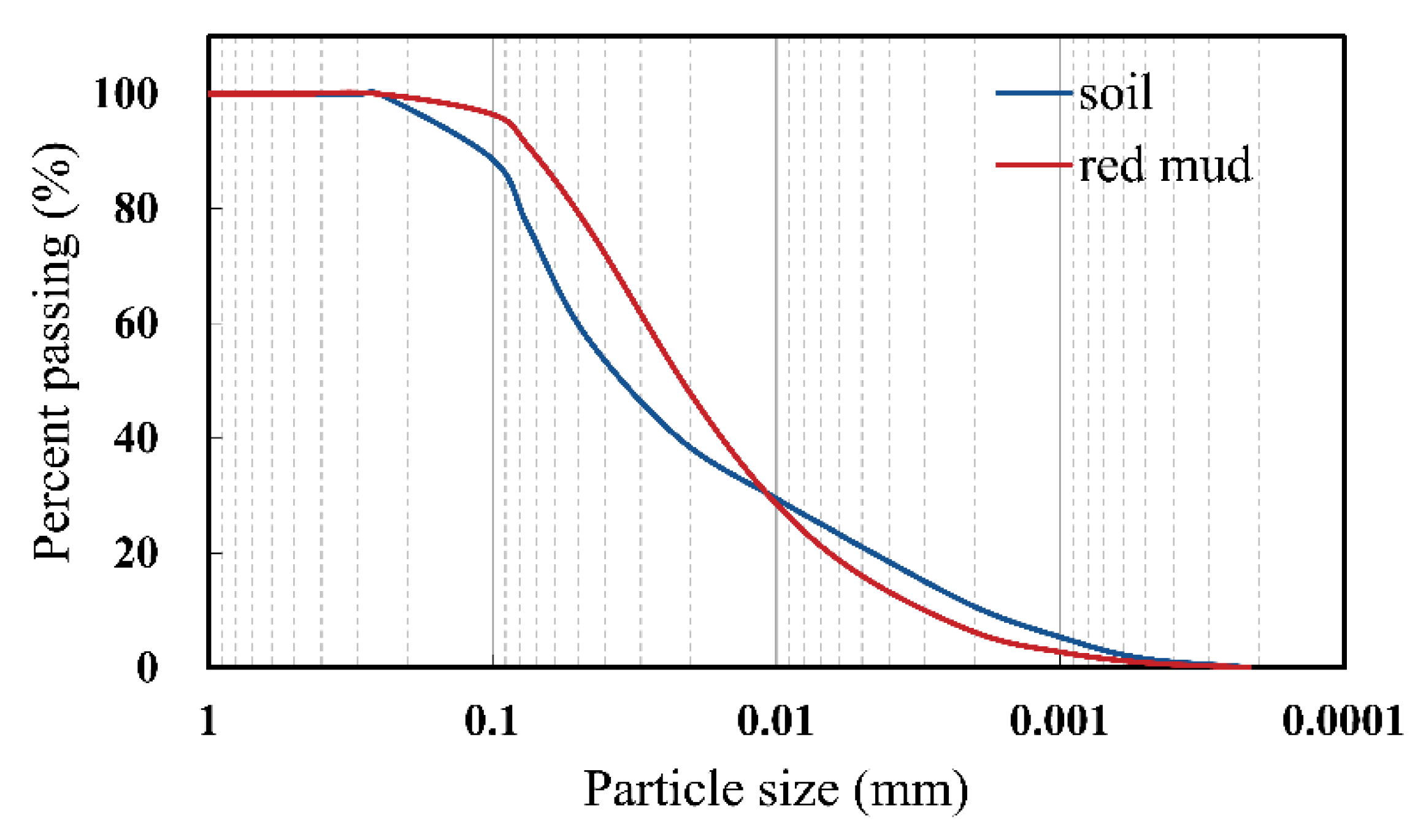
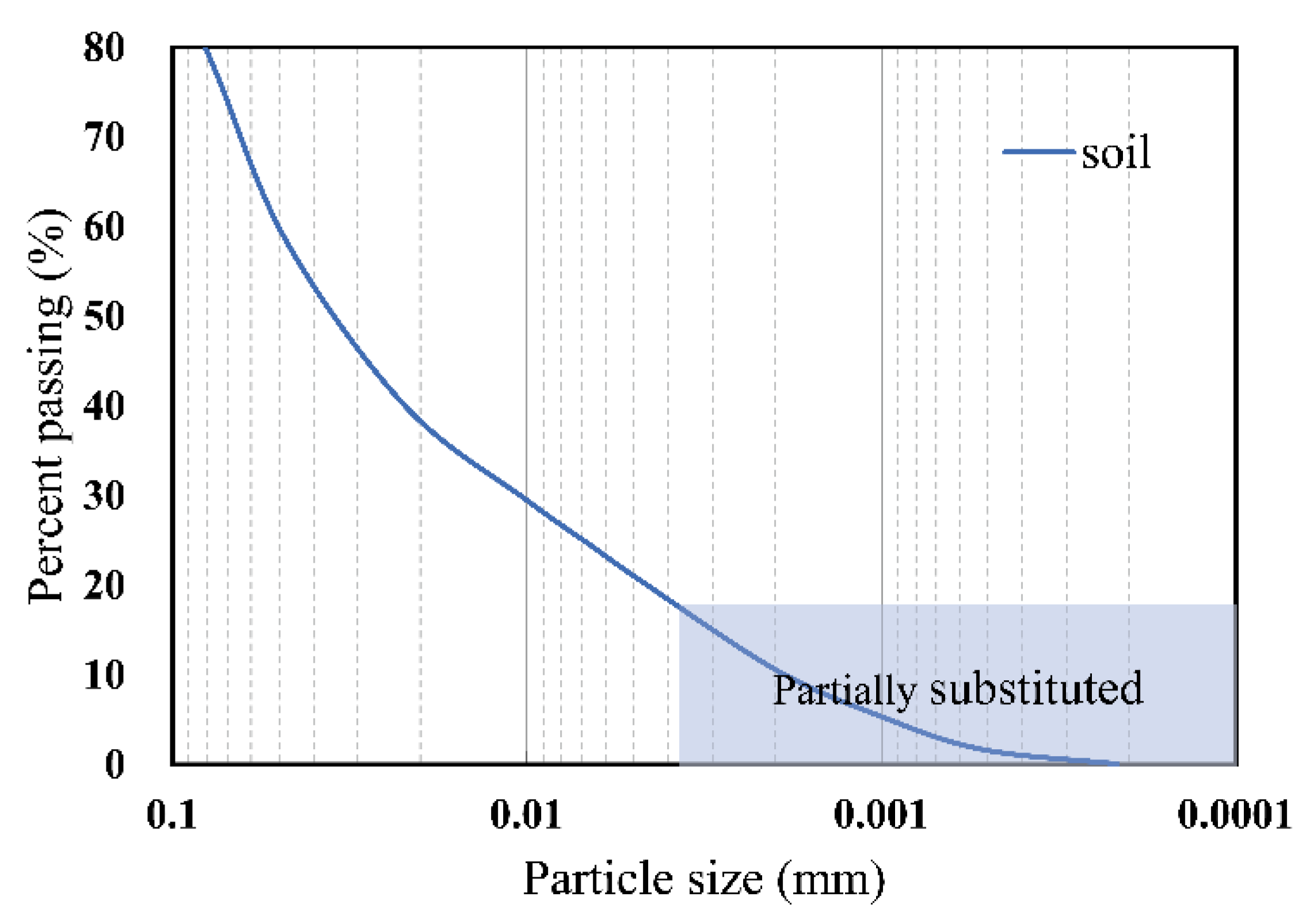





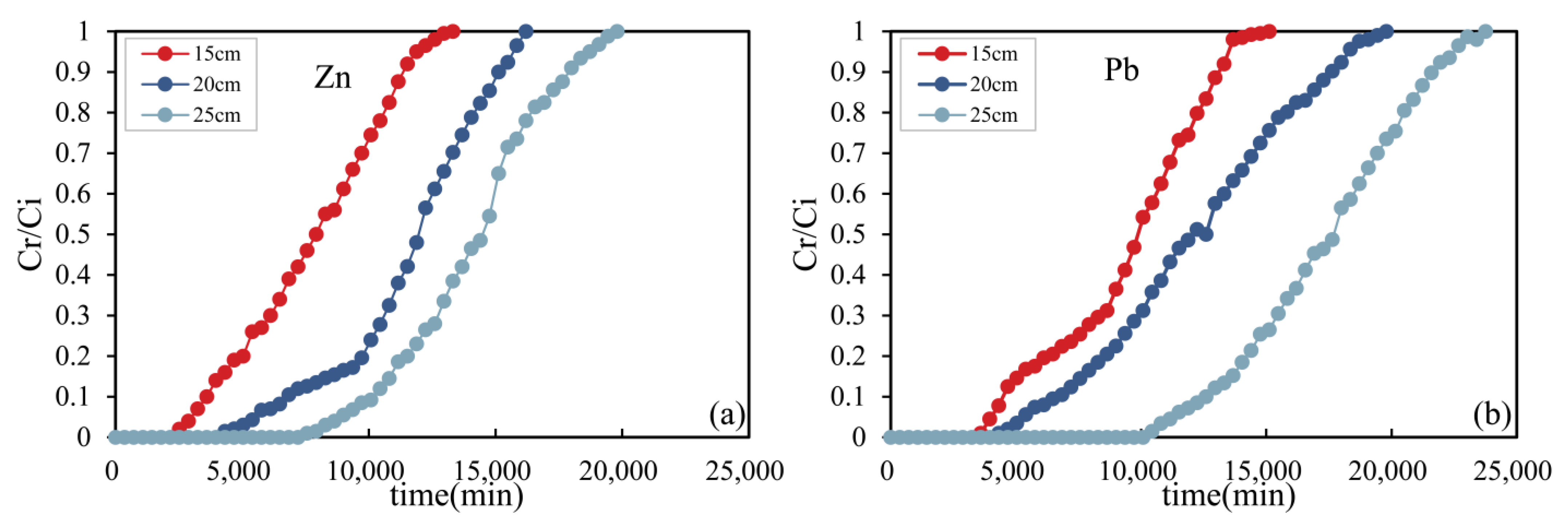
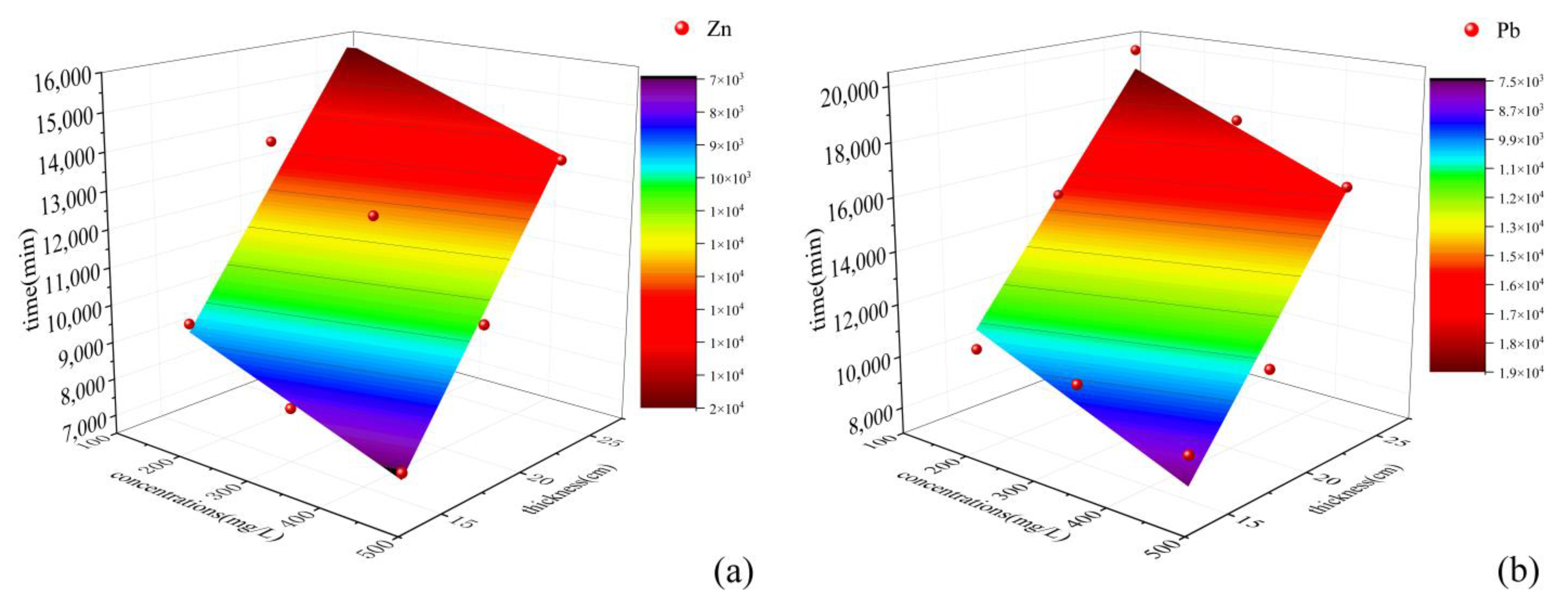
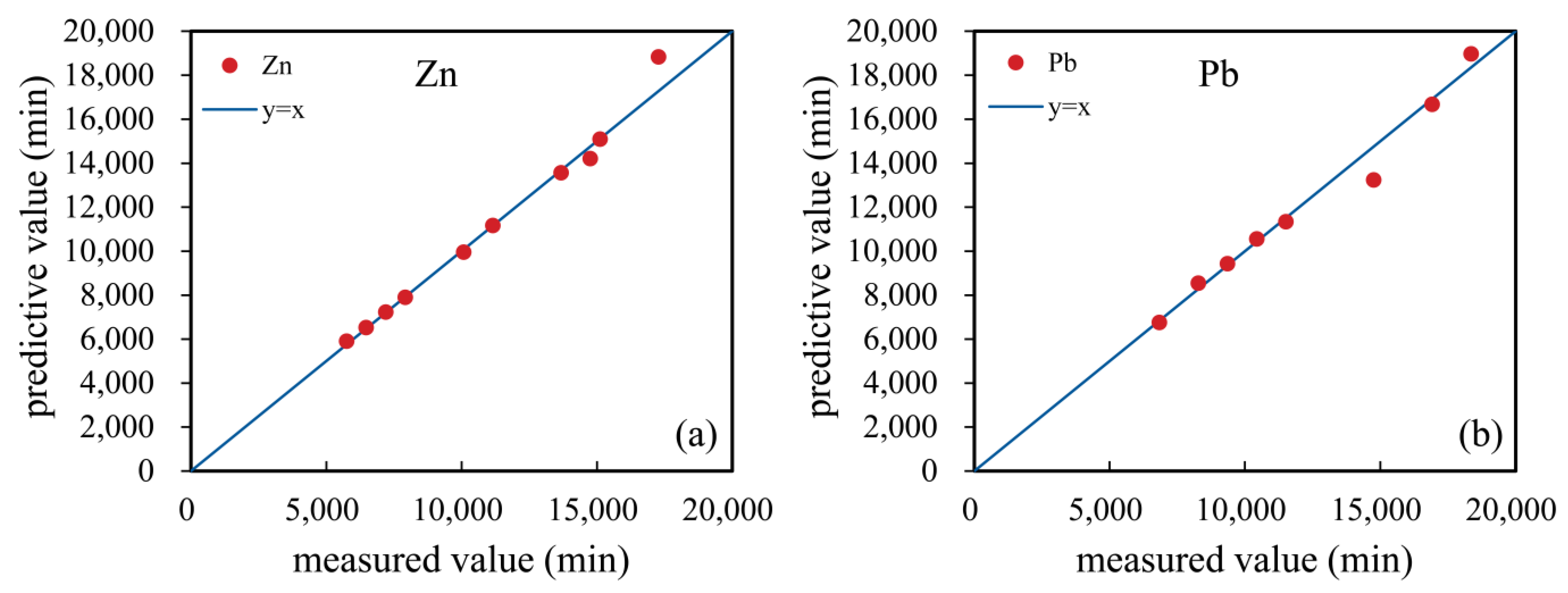
| Material | Field Soil | Red Mud |
|---|---|---|
| optimum moisture content (%) | 17.80 | 72.50 |
| specific gravity | 2.72 | 2.68 |
| pH | 6.84 | 10.38 |
| cation exchange capacity (meq/100 g) | 9.45 | 56.81 |
| specific surface area (m2/g) | 11.97 | 78.09 |
| liquid limit (%) | 37.60 | 74.60 |
| plastic limit (%) | 17.30 | 47.20 |
| Formula | Field Soil | Red Mud |
|---|---|---|
| SiO2 | 59.50% | 40.96% |
| Al2O3 | 19.28% | 22.13% |
| Na2O | 1.32% | 0.07% |
| Fe2O3 | 6.68% | 3.38% |
| CaO | 0.74% | 22.96% |
| TiO2 | - | 2.09% |
| K2O | 2.96% | - |
| LOI | 9.46% | 2.41% |
| Sample | Hydraulic Conductivity (cm/s) | Internal Friction Angle (°) | Cohesion (kPa) |
|---|---|---|---|
| A0 | 6.0 × 10−4 | 43.2 | 23.9 |
| A5 | 2.8 × 10−4 | 42.5 | 25.7 |
| A10 | 1.0 × 10−4 | 40.9 | 26.4 |
| S10 | 8.4 × 10−5 | 40.1 | 26.8 |
| A15 | 6.5 × 10−5 | 39.8 | 27.4 |
| S15 | 4.1 × 10−5 | 39.3 | 28.0 |
| A20 | 3.0 × 10−5 | 38.9 | 30.3 |
| S20 | 2.2 × 10−5 | 36.8 | 30.6 |
| A25 | 1.3 × 10−5 | 35.2 | 30.8 |
| Zinc | Langmuir Isotherm Constants | Freundlich Isotherm Constants | ||||
|---|---|---|---|---|---|---|
| 1/a | 1/ab | R2 | KF | 1/n | R2 | |
| A0 | 0.3181 | 98.7890 | 0.9446 | 0.052707 | 0.5813 | 0.9609 |
| A5 | 0.1659 | 25.8330 | 0.9888 | 0.239046 | 0.4707 | 0.8658 |
| A10 | 0.1178 | 14.0480 | 0.9942 | 0.470904 | 0.4213 | 0.8787 |
| A15 | 0.0972 | 8.9995 | 0.9945 | 0.722672 | 0.3897 | 0.8567 |
| A20 | 0.0826 | 6.8458 | 0.9783 | 1.169177 | 0.3538 | 0.8002 |
| A25 | 0.0750 | 4.9881 | 0.9654 | 1.560178 | 0.3083 | 0.7819 |
| S10 | 0.1015 | 11.6230 | 0.9960 | 0.547825 | 0.4213 | 0.8856 |
| S15 | 0.0870 | 8.6876 | 0.9842 | 0.784664 | 0.3899 | 0.8571 |
| S20 | 0.0752 | 6.9333 | 0.9653 | 1.059821 | 0.3636 | 0.8762 |
| Lead | Langmuir Isotherm Constants | Freundlich Isotherm Constants | ||||
|---|---|---|---|---|---|---|
| 1/a | 1/ab | R2 | KF | 1/n | R2 | |
| A0 | 0.1112 | 65.2630 | 0.5196 | 0.109285 | 0.5705 | 0.9074 |
| A5 | 0.0057 | 42.1690 | 0.0075 | 0.043630 | 0.8993 | 0.8972 |
| A10 | −0.0095 | 25.2280 | 0.0844 | 0.044396 | 0.9978 | 0.9572 |
| A15 | −0.0019 | 12.0130 | 0.0068 | 0.084568 | 1.0060 | 0.9584 |
| A20 | 0.0111 | 4.8554 | 0.2041 | 0.329131 | 0.8890 | 0.9205 |
| A25 | 0.0187 | 1.1193 | 0.4756 | 4.766918 | 0.3550 | 0.5556 |
| S10 | 0.0213 | 22.9740 | 0.2149 | 0.134472 | 0.7467 | 0.9370 |
| S15 | 0.0261 | 11.4780 | 0.3012 | 0.360667 | 0.6495 | 0.8071 |
| S20 | 0.0248 | 2.2065 | 0.5767 | 0.982063 | 0.6584 | 0.9391 |
Publisher’s Note: MDPI stays neutral with regard to jurisdictional claims in published maps and institutional affiliations. |
© 2022 by the authors. Licensee MDPI, Basel, Switzerland. This article is an open access article distributed under the terms and conditions of the Creative Commons Attribution (CC BY) license (https://creativecommons.org/licenses/by/4.0/).
Share and Cite
Lei, H.; Xu, X.; Liu, X.; Park, J.; Yu, Z.; Liu, H. Red Mud-Amended Soil as Highly Adsorptive Hybrid-Fill Materials for Controlling Heavy Metal Sewage Seepage in Industrial Zone. Int. J. Environ. Res. Public Health 2022, 19, 15043. https://doi.org/10.3390/ijerph192215043
Lei H, Xu X, Liu X, Park J, Yu Z, Liu H. Red Mud-Amended Soil as Highly Adsorptive Hybrid-Fill Materials for Controlling Heavy Metal Sewage Seepage in Industrial Zone. International Journal of Environmental Research and Public Health. 2022; 19(22):15043. https://doi.org/10.3390/ijerph192215043
Chicago/Turabian StyleLei, Haomin, Xin Xu, Xiaofeng Liu, Junboum Park, Zhongyu Yu, and Hao Liu. 2022. "Red Mud-Amended Soil as Highly Adsorptive Hybrid-Fill Materials for Controlling Heavy Metal Sewage Seepage in Industrial Zone" International Journal of Environmental Research and Public Health 19, no. 22: 15043. https://doi.org/10.3390/ijerph192215043
APA StyleLei, H., Xu, X., Liu, X., Park, J., Yu, Z., & Liu, H. (2022). Red Mud-Amended Soil as Highly Adsorptive Hybrid-Fill Materials for Controlling Heavy Metal Sewage Seepage in Industrial Zone. International Journal of Environmental Research and Public Health, 19(22), 15043. https://doi.org/10.3390/ijerph192215043








